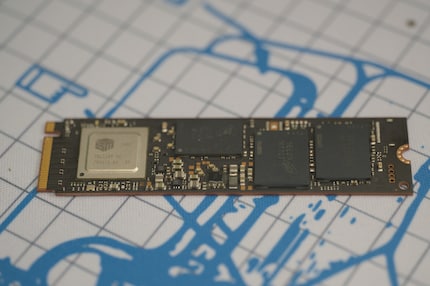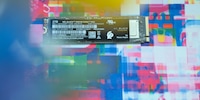

Crucial can’t reclaim the crown with the T710
Crucial has already given its top-of-the-line PCIe 5.0 SSD a second makeover. The T710 is slightly faster than its predecessor, the T705, but the differences are marginal.
Who’s the fastest? Sandisk, Samsung, Crucial and the like are in a neck-and-neck race with new releases of PCIe 5.0 SSDs. Since the end of May, Sandisk has been in the lead with the WD Black SN8100. Crucial, the previous frontrunner, isn’t prepared to accept this. The T710 is the second update to the T700, which launched in 2023. Although it’s improved slightly once again, it isn’t enough to reclaim the crown.
The technical details
I’m testing the SSD in its 2-terabyte (TB) version. One gigabyte (GB) of DRAM from Crucial’s parent company Micron is installed per TB of memory. The data allocation tables, for example, which record logical blocks and their positions in the memory, are stored on this. So if you buy a different memory size, there may be differences in the specifications.
Sandisk uses its own G9 TLC NAND for the flash. NAND is a non-volatile memory technology that doesn’t require power to store data. TLC stands for Triple Level Cell. Consequently, three states are possible per memory cell, stacked in 276 layers.
Crucial is now using the SM2508 controller from Silicon Motion instead of the Phison E26. This new one is much more economical, and the T710 should remain cooler than the T705 as a result, which did get very hot.

Crucial promises 600 terabytes written (TBW) per TB of memory. This is the number of TB that an SSD can write in its lifetime. They’re conservative values, as a rule drives can achieve more. With my test device, I could write 1 TB of data per day for over three years. Mind you, that’s an unrealistic scenario. The manufacturer’s warranty lasts five years.
Reading: only small differences
The T710 misses its promised value of 14,900 megabytes per second (MB/s) for sequential reading by around 120 MB/s. This is pretty low and within the variance of a benchmark. Any differences to rival SSDs are also very small. The new Crucial is just one per cent behind the SN8100. Still, the T710 lies 2.5 per cent ahead of its predecessor, the T705. The new model is also better at random reading, but doesn’t beat the competition from Sandisk.
The first graphic refers to sequential reading, the second to random reading. If you work with large files, the first graph will be relevant for you, the second applies for small files.
Writing: doesn’t quite achieve its promised performance
As for writing, the T710 doesn’t achieve the value promised on paper. It should reach 13,800 MB/s for sequential writing, but it’s 221 MB/s less for me. In addition, the gap to the competition has grown to four per cent compared to reading operations. The new Crucial also lags behind the SN8100 when it comes to random writing, but can still outperform its predecessor.
In a practical test, I copy a 10-gigabyte file from a RAM disk to the SSD. The RAM disk ensures that the SSD is the bottleneck, as RAM will achieve a much higher write and read rate. Here, the T710 achieves the same value as the T705 and remains just behind the Sandisk SSD.
To test how the SSD behaves when writing data continuously, I repeatedly write the 10 GB test file from the RAM disk to the SSD using a batch command. This allows me to determine when it starts to throttle down. The T710 hits the brakes for the first time after 50 GB of written data. Instead of 5,800 MB/s, it maxes out at only 4,500 MB/s. It throttles earlier than the Sandisk SSD, which only slows down after 100 GB of written data; however, that one slows down by 400 MB/s, namely to 4,100 MB/s. After one TB of written data, the Crucial slows down again to an average of 2,000 MB/s. Here, the T710 behaves similarly to the SN8100, which slows down to 2,000 MB/s a little earlier.
Copying: better, but not best
When copying, i.e. reading and writing to the SSD at the same time, I duplicate the 10 GB file. Here too, the T710 ends up between its predecessor and the SSD from Sandisk.
Office use: second once more
In Office applications, the current trend repeats itself: although the T710 beats its predecessor, it can’t displace the SN8100 from the top spot. Bear in mind, all these SSDs are lightning-fast in applications. You’ll hardly notice the benchmark differences during normal use.
Gaming: forever second
Things stay the same in 3DMark’s gaming benchmark: the T710 ranks between the SN8100 and the T705.
How the SSD behaves at 80 per cent full
I ran all my previous tests with an empty SSD. As a rule, however, you’ll fill your drive over time. At 80 per cent full, an SSD won’t always lose performance. When reading, it reaches the same value as when it’s empty. However, the SSD is three per cent slower when writing in practice. At seven per cent, the loss is greatest while copying. In my office and gaming tests, I again measured no performance losses.
Temperatures: cooler than the predecessor, but warmer than the competition
The T705 is known to get very hot. This is in part due to the built-in E26 controller, which likes to indulge in 12 watts of power. The SM2508 in the T710 is more efficient, meaning temperatures are lower too. In my continuous write test, the SSD reached a maximum temperature of 68 degrees Celsius. That’s 17 degrees less than its predecessor, but ten degrees more than the SN8100 – despite having the same controller.
The T710 can’t yet be ordered from us, delivery dates are currently being settled on.
In a nutshell
Not enough to claim the crown
With the T710, Crucial’s closing the gap to Sandisk’s SN8100. However, the new SSD lags behind the Sandisk device in all tests. If you want maximum performance, there’s currently no way around the WD Black SN8100. The Sandisk memory also has advantages over the Crucial in terms of temperature: the latter gets significantly warmer under load.
Both SSDs are very close to each other in terms of performance. During everyday use, you won’t notice any differences between the flagship SSDs of either manufacturer. If you’re satisfied with super fast, it’s best to look at prices and buy the one that’s cheapest at that moment.
Pro
- Faster than its predecessor
- Lower power consumption and lower operating temperature than predecessor as a result
Contra
- Not enough for the top spot

From big data to big brother, Cyborgs to Sci-Fi. All aspects of technology and society fascinate me.


